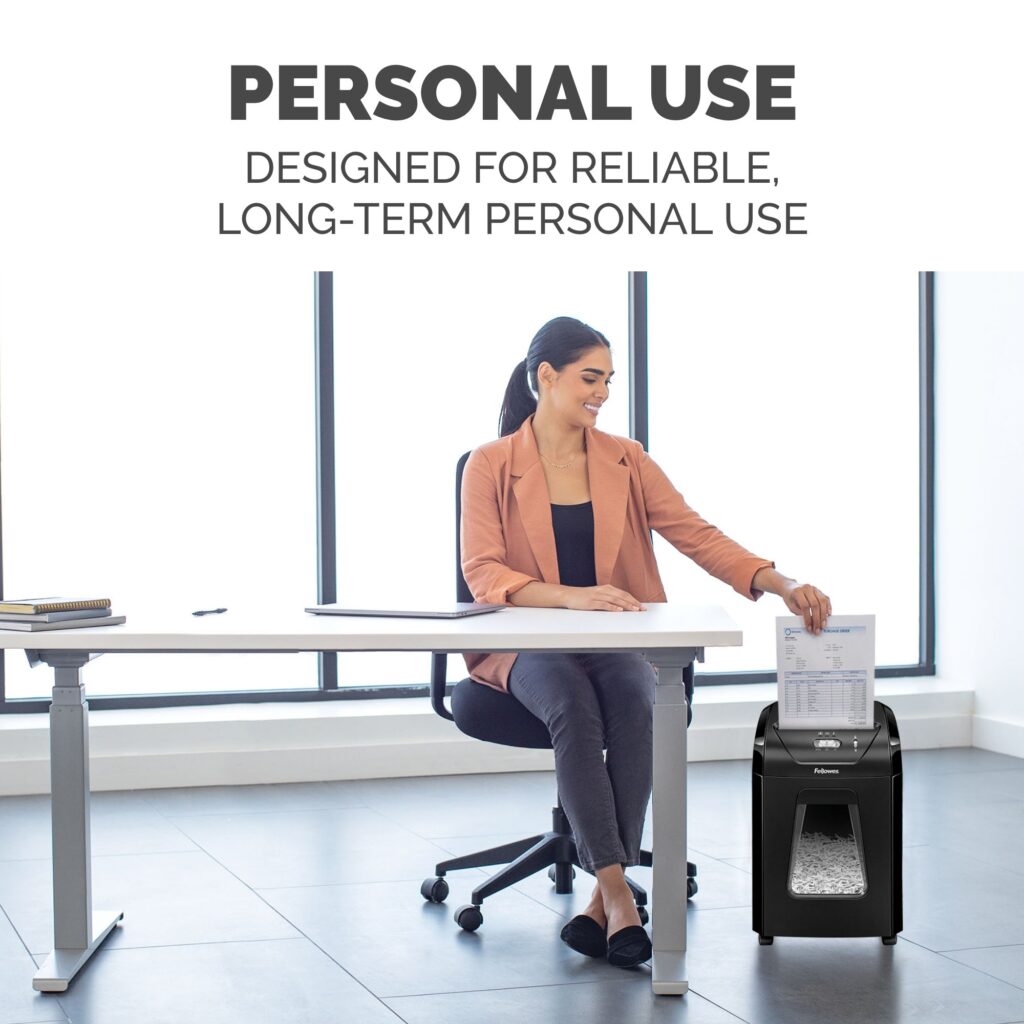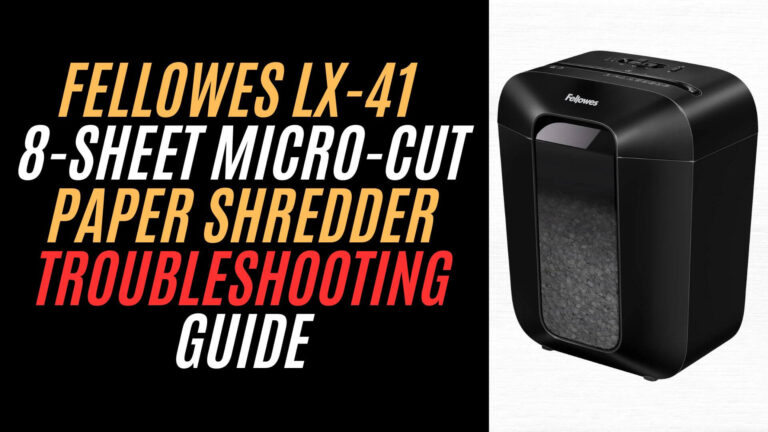The Fellowes 14C10 14-sheet cross-cut paper shredder is a reliable tool for handling your shredding needs, from sensitive documents to credit cards and staples. However, even top-notch machines like the 14C10 can occasionally encounter issues. This troubleshooting guide will help you identify common problems and their solutions, ensuring your shredder stays in tip-top shape.
Overview of the Fellowes 14C10 Shredder

Before we dive into troubleshooting, let’s review the core features of this shredder:
- Sheet Capacity: 14 sheets per pass.
- Cut Type: Cross-cut (5/32” x 1-9/16” particles).
- Run Time: Up to 10 minutes of continuous shredding.
- Safety Features: Patented Safety Lock.
- Versatility: Shreds paper, credit cards, staples, paper clips, and unopened junk mail.
- Convenience: 5-gallon pull-out bin with a mess-free design.
- Noise Control: Quiet operation for home or office use.
These features make it a perfect choice for small to medium workloads, but like any machine, proper maintenance is key to avoiding breakdowns.
Fellowes 14C10 Shredder: Common Issues and Solutions
1. Shredder Not Turning On
Possible Causes:
- Power Supply Issues: A loose or disconnected power cable can prevent the shredder from turning on.
- Safety Lock Enabled: The shredder’s Safety Lock feature may be engaged, which disables the machine.
- Internal Overheating: Running the shredder continuously beyond the recommended 10-minute runtime can trigger the automatic shut-off.
Solutions:
- Inspect Power Connection: Verify that the power cord is securely connected to a functional outlet. Test the outlet with another device if necessary.
- Safety Lock Check: Locate the Safety Lock switch on the shredder and ensure it is in the “off” position to enable operation.
- Cooling Period: Overheated shredders need approximately 20-30 minutes to cool down. Use this downtime to clean or inspect the shredder for blockages or dust buildup.
2. Paper Jams
Possible Causes:
- Exceeding the 14-sheet maximum capacity in a single feed.
- Inserting papers at an angle or unevenly.
- Shredding materials that are not suitable for this model (e.g., thick laminated sheets).
Solutions:
- Reverse Function: Switch the shredder to “Reverse” mode to dislodge the jammed paper. Gently pull the stuck paper out.
- Feed Smaller Loads: Avoid overloading the shredder. Feed smaller stacks of paper if you notice resistance.
- Lubrication Maintenance: Regularly apply Fellowes shredder oil to the cutting blades to reduce friction and keep the shredder running smoothly.
Pro Tip: Always remove larger staples or binder clips before shredding to reduce the likelihood of a jam.
3. Shredder Stops Mid-Operation
Possible Causes:
- Overheating due to exceeding the 10-minute runtime.
- Full waste bin triggering an automatic stop.
- Blocked internal sensors due to accumulated dust or paper particles.
Solutions:
- Cool Down Period: Allow the shredder to rest for 20-30 minutes to avoid further overheating. Consider breaking larger shredding tasks into smaller sessions.
- Empty Waste Bin: Pull out the 5-gallon bin and empty it before continuing. A full bin can prevent the shredder from operating.
- Sensor Cleaning: Use a soft, lint-free cloth to gently wipe the internal sensors located near the paper entry and waste bin area. This ensures the shredder detects paper accurately.
4. Strange Noises or Vibrations
Possible Causes:
- Misalignment of internal components or cutting blades.
- Foreign objects, such as paperclips or debris, caught in the shredder.
- Lack of proper lubrication leading to increased friction.
Solutions:
- Inspect Internals: Turn off and unplug the shredder. Open the machine carefully and check for stuck items, such as staples or paper fragments.
- Lubricate Blades: Regularly oil the shredder blades to reduce noise and vibration. Apply oil directly into the feed slot and run a few blank sheets of paper to spread it evenly.
- Alignment Check: Ensure the cutting assembly is properly seated. Refer to the manual for reassembly instructions if needed.
Pro Tip: Avoid using the shredder on an uneven surface, as this can amplify vibrations.
5. Shredder Doesn’t Start Automatically
Possible Causes:
- Blocked or dirty auto-start sensors.
- Paper not correctly aligned with the shredder’s throat.
Solutions:
- Clean Auto-Start Sensors: Dust and paper debris can accumulate on the sensors near the paper entry. Gently clean these areas with a soft cloth to restore functionality.
- Proper Paper Alignment: Ensure the paper enters the slot straight and evenly. If the paper is crumpled or folded, straighten it before feeding.
Pro Tip: Run a maintenance sheet through the shredder occasionally. These sheets clean and lubricate the internal components for better auto-start performance.
6. Shredder Overheats Frequently
Possible Causes:
- Overuse beyond the recommended runtime.
- Poor ventilation around the shredder.
- Excessive shredding without allowing for cooling.
Solutions:
- Adhere to Runtime Limits: Follow the recommended 10-minute maximum runtime. After completing this, allow the machine to cool for at least 20 minutes.
- Improve Ventilation: Place the shredder in a well-ventilated area to facilitate heat dissipation. Avoid placing it in enclosed or poorly ventilated spaces.
- Regular Maintenance: Keep the shredder clean and well-lubricated to reduce strain on the motor, which can contribute to overheating.
7. Poor Shredding Performance
Possible Causes:
- Blunt cutting blades from lack of maintenance.
- Feeding incorrect materials or improperly aligned items.
Solutions:
- Blade Maintenance: Lubricate the shredder blades frequently to keep them sharp and reduce wear. Use only recommended shredder oil for this purpose.
- Check Materials: Ensure you are shredding materials the machine is designed for. Avoid feeding thick plastic sheets, oversized paper, or non-paper items unless specified.
- Even Paper Feeding: Insert paper evenly and at the center of the paper entry slot to ensure efficient shredding.
Proactive Maintenance for Long-Term Performance
To avoid recurring issues, incorporate the following practices:
- Scheduled Lubrication: Oil the shredder blades every 30 minutes of operation or at least once a month during regular use.
- Routine Cleaning: Wipe down the sensors, cutting assembly, and bin compartment to prevent blockages.
- Shredding Capacity Awareness: Never exceed the maximum sheet limit, even if the shredder seems to handle extra paper. This reduces strain on the motor and blades.
- Temperature Monitoring: If the shredder feels warm or begins to slow down, allow it to cool off even before the runtime is exhausted.
When to Seek Professional Help
If these solutions don’t resolve the issue, or if the shredder shows physical damage, it may require professional servicing. Fellowes offers a 1-year machine warranty and a 5-year cutter warranty, so reach out to their customer service team for assistance. Their support is often praised for its responsiveness and efficiency.
Frequently Asked Questions about Fellowes 14c10 Paper Shredder
Why Choose the Fellowes 14C10?
Despite occasional troubleshooting, the Fellowes 14C10 stands out for its:
- High Security: The P-4 security level ensures that sensitive documents are thoroughly destroyed.
- Versatility: Shreds more than just paper, making it ideal for modern home offices.
- User-Friendly Design: With features like a pull-out bin and a safety lock, it’s safe and easy to use.
What is the maximum sheet capacity per pass?
The shredder can handle up to 14 sheets of paper per pass.
What is the security level of the shredded particles?
It provides a P-4 security level, shredding documents into 5/32″ x 1-9/16″ cross-cut particles.
Can it shred materials other than paper?
Yes, the shredder can also shred credit cards, paper clips, staples, and unopened junk mail.
What is the continuous run time before needing to cool down?
The shredder can operate continuously for up to 10 minutes before requiring a cool-down period.
How long is the cool-down period after continuous use?
The specific cool-down period isn’t detailed in the provided information. It’s recommended to allow sufficient time for the shredder to cool to prevent overheating.
What is the capacity of the waste bin?
The shredder features a 5-gallon pull-out bin that can contain over 250 shredded sheets.
Does the shredder have safety features?
Yes, it comes equipped with a patented Safety Lock that disables the machine as needed to protect users, their families, or pets.
Is the shredder designed for quiet operation?
Yes, it is designed to minimize noise, preventing distractions in shared workplaces or at home.
What are the dimensions of the shredder?
The shredder measures 19.69 inches in height, 13.44 inches in width, and 9.69 inches in depth.
What is the warranty period for the shredder?
Fellowes offers a 1-year warranty on the machine and a 5-year warranty on the cutter.
Does it have an auto start/stop feature?
Yes, the shredder includes an electronic auto start/stop feature for ease of use.
What is the throat width of the shredder?
The paper entry width is 9 inches, accommodating most standard paper sizes.
Can the shredder handle continuous shredding without jamming?
While the shredder is designed for efficient shredding, it does not have specific jam prevention features. It’s advisable not to exceed the maximum sheet capacity and to regularly maintain the shredder to prevent jams.
Is there a recommended number of users for this shredder?
The shredder is recommended for use by one person, making it ideal for personal or home office use.
What is the cutting speed of the shredder?
The shredder operates at a speed of 8 feet per minute, allowing for efficient shredding tasks.
Does the shredder have a reverse function?
Yes, the shredder includes a reverse function to help clear paper jams and ensure smooth operation.
What type of motor does the shredder use?
The specific motor type isn’t detailed in the provided information. However, the shredder is designed for medium use, balancing performance and durability.
Is the shredder energy efficient?
While the shredder includes features like auto start/stop to conserve energy, specific energy efficiency ratings aren’t provided.
Can the shredder be used to destroy CDs or DVDs?
The provided information does not specify the ability to shred CDs or DVDs. It’s recommended to consult the user manual or contact Fellowes directly for confirmation.
How should the shredder be maintained for optimal performance?
Regular maintenance includes emptying the waste bin to prevent overflows, periodically oiling the cutting blades to maintain efficiency, and ensuring the shredder is used within its specified capacity to prevent jams and extend its lifespan.
Final Thoughts
Owning a Fellowes 14C10 shredder can make managing sensitive documents effortless, but maintenance and care are essential for longevity. By understanding common problems and their solutions, you can keep your shredder running smoothly for years.
Got more questions? Fellowes customer service and their detailed manual are always there to help. Happy shredding!



